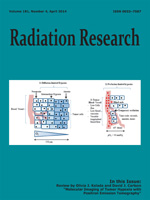The emergence of the threat of radiological terrorism and other radiological incidents has led to the need for development of fast, accurate and noninvasive methods for detection of radiation exposure. The purpose of this study was to extend radiation metabolomic biomarker discovery to humans, as previous studies have focused on mice. Urine was collected from patients undergoing total body irradiation at Memorial Sloan-Kettering Cancer Center prior to hematopoietic stem cell transplantation at 4–6 h postirradiation (a single dose of 1.25 Gy) and 24 h (three fractions of 1.25 Gy each). Global metabolomic profiling was obtained through analysis with ultra performance liquid chromatography coupled to time-of-flight mass spectrometry (TOFMS). Prior to further analyses, each sample was normalized to its respective creatinine level. Statistical analysis was conducted by the nonparametric Kolmogorov-Smirnov test and the Fisher's exact test and markers were validated against pure standards. Seven markers showed distinct differences between pre- and post-exposure samples. Of those, trimethyl-l-lysine and the carnitine conjugates acetylcarnitine, decanoylcarnitine and octanoylcarnitine play an important role in the transportation of fatty acids across mitochondria for subsequent fatty acid β-oxidation. The remaining metabolites, hypoxanthine, xanthine and uric acid are the final products of the purine catabolism pathway, and high levels of excretion have been associated with increased oxidative stress and radiation induced DNA damage. Further analysis revealed sex differences in the patterns of excretion of the markers, demonstrating that generation of a sex-specific metabolomic signature will be informative and can provide a quick and reliable assessment of individuals in a radiological scenario. This is the first radiation metabolomics study in human urine laying the foundation for the use of metabolomics in biodosimetry and providing confidence in biomarker identification based on the overlap between animal models and humans.
How to translate text using browser tools
27 March 2014
Development of a Metabolomic Radiation Signature in Urine from Patients Undergoing Total Body Irradiation
Evagelia C. Laiakis,
Tytus D. Mak,
Sebastien Anizan,
Sally A. Amundson,
Christopher A. Barker,
Suzanne L. Wolden,
David J. Brenner,
Albert J. Fornace
ACCESS THE FULL ARTICLE

Radiation Research
Vol. 181 • No. 4
April 2014
Vol. 181 • No. 4
April 2014




